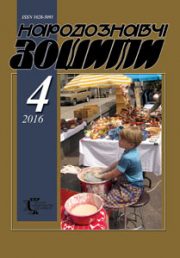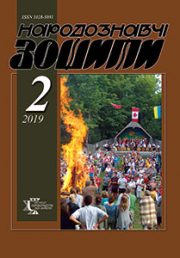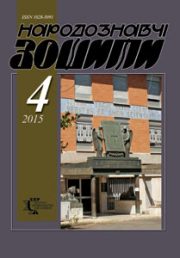The Ethnology Notebooks. 2024. № 5 (179), 1308—1317
UDK [745.048:398.332.12](477=161.2):069.538]:001.891
DOI https://doi.org/10.15407/nz2024.05.1308
KLIMASHEVSKYI Andriy
- Candidate of Art Studies,
- deputy director of research and museum work,
- Institute of Ethnology of the National Academy of Sciences of Ukraine,
- Prospekt Svobody, 15, 79000, Lviv, Ukraine,
- Contacts: e-mail: aklimashewskyi@gmail.com
Abstract. The scientific and museum integrity of the largest and oldest collection of Easter eggs in Ukraine, formed on the basis of the collection of the Museum of Shevchenko Scientific Society in the context of implementation in 2024, is analyzed and based on the grant program of the Ukrainian Cultural Fund.
The purpose of the article is to publish information in the scientific environment about the conceptual, methodological foundations and results of the grant project supported by the Ukrainian Cultural Foundation “Ukrainian Easter egg in the European cultural space”, based on research, attribution, digitization, promotion in the format of a web catalog and the formation of 3D- models of the most iconic artifacts of the oldest part of the Easter egg fund.
The object of the study is Easter eggs from the collection of the National Academy of Sciences, selected according to the territorial principle in the context of ethnographic regions.
The methodology of the project within the framework of the UKF is based on a systematic approach in the selection of the most historically significant and attractive monuments from a separate museum fund of Easter eggs in the amount of 287 units for 3D digitization, multi-focal photo fixations, digitization and high-quality presentable presentation in the modern cultural and museum internet – spaces.
The research is based on the comparative-historical method based on the territorial principle with the selection of 2-chronological periods:
1. Monuments of the end of the 19th century. — before the beginning of World War I.
2. Monuments of the interwar period until 1939 (the beginning of World War II).
All artifacts are considered in the context of ethnographic zoning based on the disclosure of pysanka traditions of different regions with their own local world of symbols, ornamentation, and color.
The main criteria for selecting Easter eggs were:
1. By the time of creation (admission to the museum collection).
2. By regional specificity (ethnographic region of origin).
3. According to the existence of a local original tradition.
4. By state of preservation.
5. By execution technique.
6. On ornamental motifs.
Keywords: pysanka, grant project of the Ukrainian Cultural Fund, pysanka fund IN NASU, museum of NTSH, 3D models of pysanka, web catalog, project methodology, criteria for selection of monuments, the oldest and largest collection of pysanka.
Received 30.10.2024
REFERENCES
- Vitovets Ulrike. (2008). Inventory and digitization of museum cultural heritage on the example of Lower Austria. The modern museum: between the treasury and the enterprise. Materials of the International Conference. October 8-10, 2006. Chernivtsi (P. 82). Lviv: edition of VNTL-Klasyka [in Ukrainian].
- Hnatyuk V. (1923). Shevchenko Scientific Society. On the occasion of the 50th anniversary of its founding (1873—1923) (P. 9). Lviv: Shevchenko Scientific Society printing house [in Ukrainian].
- Manko V. (2005). Ukrainian folk Easter egg (P. 10). Lviv: Svichado [in Ukrainian].
- Corduba M. (2018). Pysanky in Galician Volyn (P. 3). Kharkiv: Publisher Oleksandr Savchuk [in Ukrainian].
- Gurgula I. Easter eggs. Ukrainian general encyclopedia (Pp. 480—481). Edited by I. Rakovsky. Volume 3. Lviv; Stanislavov; Kolomyia: Home school [in Ukrainian].







